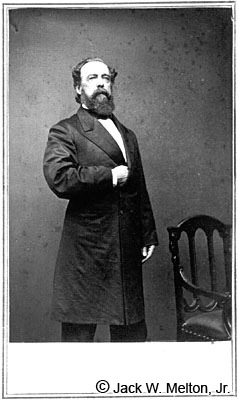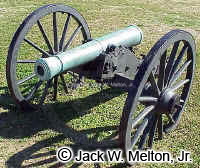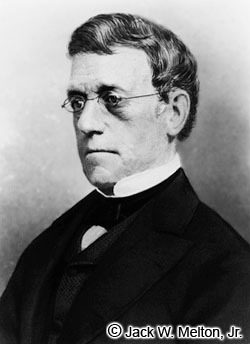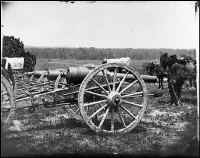Caliber-to-pounder Relationship
Prior to the outbreak of the Civil War, the arsenals of the United States Army did not carry any rifled cannon on their inventory. Although several rifled cannon had been produced, the army continued to depend on smoothbore artillery weapons. It was a common practice to refer to these weapons as “pounder” according to the weight of the solid projectile fired from the tubes. This term has led to confusion when collectors interchange it with the weight of a projectile. The correct term usage is “pounder” for the weapon and “pounds” for the shot.
In addition to the weight nomenclature, smoothbore weapons were also classified by the bore diameter in inches (also known as caliber). This worked fine for the smoothbores since the diameter of the bore and the diameter of the shot remained constant for a given weight, i.e. the bore diameter of a 32-pounder was always 6.4 inches.
Soon after the Civil War began, the army realized the advantages of having rifled weapons that could fire elongated projectiles across greater distances. In addition to ordering new weapons, the government also set about to rifle the older smoothbore guns. Now, even though the bore diameter remained the same, the weight of the projectile could be changed by being lengthened or shortened. The alteration of smoothbores, along with the projectiles, led to confusion during the Civil War, as well as being confusing for today’s collectors and students.
A
common weapon that was re-bored was the bronze Model 1841, also known as a
3.67-inch gun or a 6-pounder.  This
cannon was converted from a smoothbore to a rifled weapon by the James system
of rifling, developed by General Charles T.
James to accommodate his new shell, which required special rifling.
Because the rifling allowed a larger shell to be fired, about 12
pounds, these guns were incorrectly referred to as 12-pounders.
In some reports these guns were also referred to as “James Rifles,”
which is also misleading since there was also a 14-pounder
(3.8-inch) bronze field piece manufactured for General James in 1861,
which carried the “James Rifle” nomenclature.
This
cannon was converted from a smoothbore to a rifled weapon by the James system
of rifling, developed by General Charles T.
James to accommodate his new shell, which required special rifling.
Because the rifling allowed a larger shell to be fired, about 12
pounds, these guns were incorrectly referred to as 12-pounders.
In some reports these guns were also referred to as “James Rifles,”
which is also misleading since there was also a 14-pounder
(3.8-inch) bronze field piece manufactured for General James in 1861,
which carried the “James Rifle” nomenclature.
The 3.67- and 3.8-inch bronze Model 1841 pattern had a bore length of 57.5 inches and fired a projectile with a powder charge of 1.25 pounds. The ammunition was short and light, usually of the James and Schenkl pattern. The 900 pound U.S. Model No. 1 carriage common with these tubes could not withstand the violent recoil a higher charge for heavier projectiles produced. Carriage and tube together weighed 1,785 pounds. Even with the light weight tube, many of these carriages failed in the field and, in 1864, the carriage was redesigned to make it stronger.
It
should be noted that many of the 3.67-inch smoothbore
 guns were re-bored to
3.8-inches in order to make the bore interior completely smooth before
rifling. As a result, most of the
true 3.67-inch rifles in existence today, were manufactured as rifles instead
of being converted. Guns made by
Ames Company in Massachusetts, Miles Greenwood of Ohio (Eagle Iron Works), and
William Marshall and Company of St. Louis, Missouri, are examples of this
type. The image to your right is an example of a Miles
Greenwood manufactured Model 1841 6-pounder (3.67-inch caliber) smoothbore
bronze cannon that was re-bored to 3.80-inches with James rifling.
guns were re-bored to
3.8-inches in order to make the bore interior completely smooth before
rifling. As a result, most of the
true 3.67-inch rifles in existence today, were manufactured as rifles instead
of being converted. Guns made by
Ames Company in Massachusetts, Miles Greenwood of Ohio (Eagle Iron Works), and
William Marshall and Company of St. Louis, Missouri, are examples of this
type. The image to your right is an example of a Miles
Greenwood manufactured Model 1841 6-pounder (3.67-inch caliber) smoothbore
bronze cannon that was re-bored to 3.80-inches with James rifling.
Another
confusing caliber to pounder relationship exists when discussing the Parrott
weapons. For
example, the same 8-inch Parrott rifle was referred to as a “200-pounder”
by the army and a “150-pounder” in the navy.
The confusion existed because the original 200 pound projectile had
been shortened, thus reducing the weight to 150 pounds. The navy carried the new designation while the army retained
the older. The 10-inch Parrott
was known as a 300-pounder, even though it actually fired a shell weighing
about 250 pounds.
The 6.4-inch Parrott, known as a 100-pounder, fired several types of
solid shots and bolts, many of which varied from the designated weight.
The
10-pounder Parrott rifles were manufactured with two different bore diameters.
An early war model had a 2.9-inch bore, while the model produced in
1863 had a 3-inch bore. Yet both
of these cannon are commonly referred to as 10- and, sometimes, 12-pounders,
even though the ammunition used varied in weight. The 2.9-inch caliber
Parrott rifle is, and should be, referred to as a 10-pounder Parrott rifle and
the 3-inch caliber should be referred to as only a Model 1863 3-inch caliber
Parrott rifle, not a 10-pounder Parrott rifle.
The
20-pounder Parrott gun, although having the same bore diameter of the Model
1841 (3.67-inch),
The
20-pounder Parrott could fire the light (12 to 14 pounds) 3.67-inch
projectiles of the Model 1841, with proper adjustments in the range tables.
However, the 3.67-inch Parrott projectiles (approximately 20-pounds) could not be
fired from the Model 1841 without fear of a failure of the tube and carriage.
The
difference in the weight of the 3.67-inch projectiles (approximately 12-14
pounds) was due to differences
in the sabots and lengths of the projectiles. The
20-pound Parrott projectiles had short bodies and a short expanding cup sabot. The
solid iron Parrott projectile weighed between 19- and 20-pounds.
The 3.67-inch Parrott shells were comprised of longer bodies, which
allowed for more room for filler powder or case shot, and also weighed nearly
20-pounds fully charged. Range tables used in a
mixed artillery unit (all three projectiles being used) had to contain
separate elevations, ranges, and flight times, so fuzes could be adjusted
accordingly.
Classification
of Parrott rifles was originally stamped on the face of the muzzle with both
designations – i.e. “3.67-in. 20 Pdr.”
However, because of the confusion existing over the weight of the
projectiles, the larger guns soon became known by the bore diameter.
This should be kept in mind by the collector or student when attempting
to determine which projectiles were fired by which weapon.
Even
though the Eastern armies had standardized field artillery batteries by late
1862, the Western armies, along with the Confederates, used a mixture of guns
throughout the war. Therefore, it
is not unusual for the collector to find a mixture of light and heavy
3.67-inch projectiles at late war battlefields.
Early
collectors once classified all 3.67-inch projectiles as being 20-pounder
Parrott ammunition. However, the final determination must be made based on the
weight, length, and sabot of the shell. These
cannon, designed by Robert Parker Parrott,
were manufactured in several sizes during the war.
The Parrott traditionally is referred to by its numerical pounder
designation, but this can be misleading.
These
cannon, designed by Robert Parker Parrott,
were manufactured in several sizes during the war.
The Parrott traditionally is referred to by its numerical pounder
designation, but this can be misleading.
 had a bore length of 79 inches. This allowed it to fire a 20-pound projectile with a
two-pound powder charge, nearly twice as powerful as the Model 1841, yet the
same diameter. The carriage (a Number 3) and tube of this Parrott weighed
2,850 pounds total, more than a half-ton heavier than the Model 1841 3.67-inch
assembly.
had a bore length of 79 inches. This allowed it to fire a 20-pound projectile with a
two-pound powder charge, nearly twice as powerful as the Model 1841, yet the
same diameter. The carriage (a Number 3) and tube of this Parrott weighed
2,850 pounds total, more than a half-ton heavier than the Model 1841 3.67-inch
assembly.